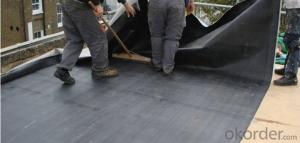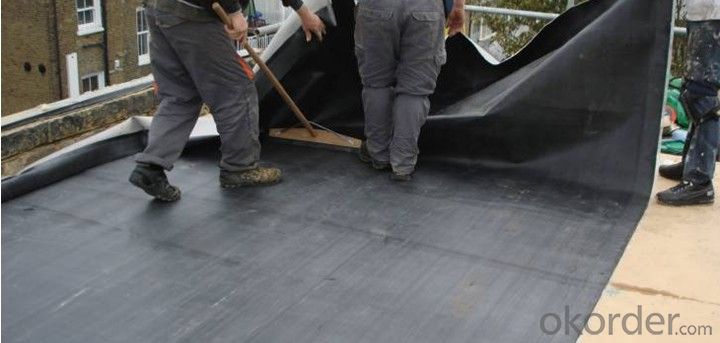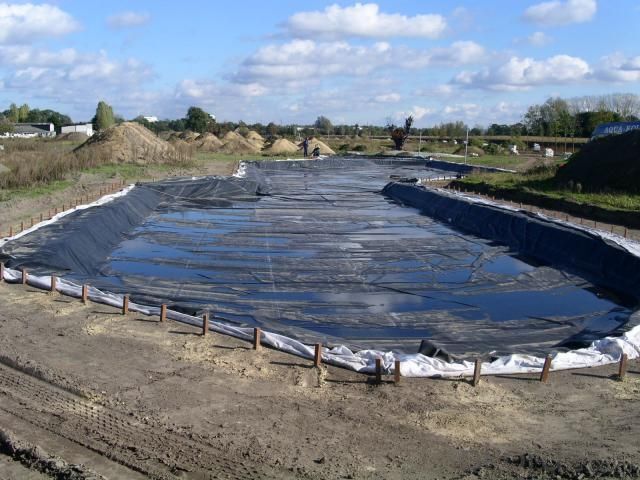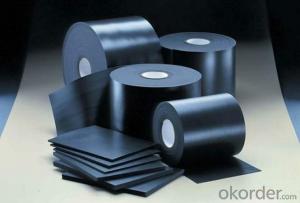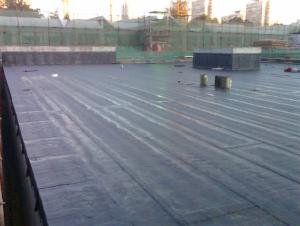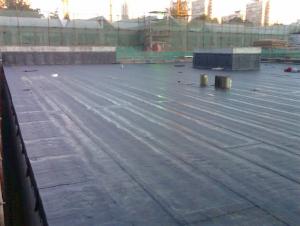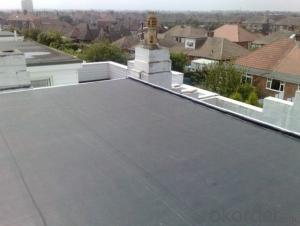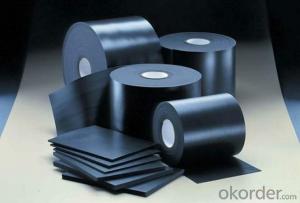EPDM Rubber Coiled Waterproof Membrane for Brick Roof
- Loading Port:
- Shanghai
- Payment Terms:
- TT OR LC
- Min Order Qty:
- 50000 m²
- Supply Capability:
- 5000000 m²/month
OKorder Service Pledge
OKorder Financial Service
You Might Also Like
EPDM Rubber Coiled Waterproof Membrane for Brick Roof
Description Of EPDM Rubber Coiled Waterproof Membrane for Brick Roof:
•EPDM waterproof sheet has excellent anti-ozone-aging performance, able to resist ultraviolet light and corrosion of many chemical corrosive materials in the atmosphere
•It has high tensile strength, high ductility and strong retractility, it has excellent crack resistance, able to effect waterproof function even with tiny vibration of buildings.
• Excellent resistance to ozone, oxidation and sunlight.
• Resistance to chemicals; resistant to most inorganic products.
Main Features of EPDM Rubber Coiled Waterproof Membrane for Brick Roof:
1>Excellent antiaging performance, service life up to 50 years
2>Working well with in 40C to 100C,it canbe constructed with a single layer in ambient temperature.
3>Waterproofing on various kinds of underground project,industrial of civil buildings and structures.
4>high extension rate, high tensile strength, small size changes at heat treatment
5>Good plant roots penetrability resistance and can be made waterproofing layer of planting roof
6>Special modified molecular structure ,effectively resolving the current domestic and foreign glue joint problem.
7>Good low temperature flexibility, and good performance of adapting to ambient temperature changes.
8>Convenient application ,solid joint, no environment pollution
9>chemical corrosion Resistance, can be used for special occasions
10>Convenient maitenance, low cost.
Specifications of EPDM Rubber Coiled Waterproof Membrane for Brick Roof:
| Material | EPDM Rubber |
| Size | 1.2m (width)*20m (length) or customized, weldable type 2.05m or 4m width |
| Thick | 1.2mm, 1.5mm, 2.0mm |
| Type | Vulcanized & Weldable |
| Pattern | Non-reinforced (homogeneous) |
| Certificate | ISO9001/14001 |
Applications of EPDM Rubber Coiled Waterproof Membrane for Brick Roof:
Widely used in roofs, basement, toilet ,swimming pool, and all kinds of industry and civil building waterproofing, reservoir, vivicism, bridge, underground, tunnel and dam waterproofing ,especially to the keystone waterproofing projects which is durability, high corrosion resistance and easy deformation.



IMages of EPDM Rubber Coiled Waterproof Membrane for Brick Roof:




FAQ of EPDM Rubber Coiled Waterproof Membrane for Brick Roof:
1. What are we supplying?
We are specialized in producing Colorful Asphalt Roof Shingle, SBS/APP modified bitumen waterproof membrane, Self adhesive bitumen waterproof membrane, PVC waterproofing membrane, EPDM rubber roofing membrane, Single Component Polyurethane Waterproof Coating, and Spray Polyurea Waterproof Coating
.
2. How Many years experience do we have?
We have been exported to more than 20 countries in the past 15 years.
3. How long do we usually reply your request?
We always reply our customer within 24 hours.
- Q: Are waterproofing membranes resistant to sulfuric acid exposure?
- Waterproofing membranes typically do not possess resistance against sulfuric acid exposure. Sulfuric acid, being an immensely corrosive substance, has the potential to inflict substantial harm to various materials, including waterproofing membranes. The membrane's deterioration can occur as a result of sulfuric acid's highly acidic properties, ultimately causing its failure. Hence, if there exists a chance of sulfuric acid exposure, it becomes crucial to employ materials that are explicitly engineered to endure such corrosive substances.
- Q: What is the difference between SBS and APP rolls?
- Second, APP modified asphalt waterproofing membrane (polyester tire): Features: Good elasticity, heat resistance and resistance to UV aging; its softening point above 150 ℃; temperature range of use -15 ℃ ~ 130 ℃; good corrosion resistance, high self-ignition point (265 ℃); Low temperature performance slightly lower than the SBS waterproofing membrane; hot melt is very good, very suitable for hot melt construction. Scope: Compared with the SBS waterproofing membrane, in addition to the general use of the project, APP modified asphalt waterproofing membrane because of better heat resistance and has excellent resistance to UV aging, more suitable for high temperature hot or ultraviolet radiation Area of ??building waterproof.
- Q: Can a waterproofing membrane be used for a shopping mall underground parking?
- Yes, a waterproofing membrane can be used for a shopping mall underground parking. Waterproofing membranes are commonly used in underground structures to prevent water infiltration and protect against potential water damage. By installing a waterproofing membrane, it helps to create a barrier that prevents water from seeping into the underground parking area, ensuring its long-term durability and protection against water-related issues.
- Q: How does a waterproofing membrane handle water infiltration from below?
- A waterproofing membrane is specifically designed to handle water infiltration from below by creating a barrier that prevents moisture from seeping through. These membranes are typically made from materials such as rubber, PVC, or modified bitumen, which are inherently resistant to water penetration. When installed correctly, a waterproofing membrane is applied to the surface of a structure's foundation or basement walls, creating a continuous and impermeable layer. This membrane acts as a protective shield, preventing water from entering the structure through the foundation walls or basement floor. The membrane is typically installed in multiple layers, ensuring maximum protection against water infiltration. The layers are often overlapped and sealed together to create a seamless and watertight barrier. Additionally, the membrane may be reinforced with fabric or mesh to provide added strength and durability. In cases where there is a high water table or excessive hydrostatic pressure from the surrounding soil, the waterproofing membrane may be combined with a drainage system. This system helps to divert water away from the structure, relieving pressure and reducing the risk of water infiltration. Overall, a waterproofing membrane effectively handles water infiltration from below by creating a durable and impermeable barrier that prevents moisture from entering the structure. By installing a properly designed and installed waterproofing system, property owners can ensure long-term protection against water damage and structural deterioration.
- Q: Can waterproofing membranes be used on wood surfaces?
- Yes, waterproofing membranes can be used on wood surfaces. Waterproofing membranes are versatile products that can be applied to a variety of materials, including wood. They are designed to create a protective barrier that prevents water from penetrating the surface, thereby preventing damage caused by moisture, such as rotting, warping, or mold growth. When applied correctly, waterproofing membranes can effectively seal wood surfaces, making them resistant to water absorption and increasing their durability and lifespan. It is important to choose a waterproofing membrane that is specifically formulated for wood applications and follow the manufacturer's instructions for proper application and maintenance.
- Q: Can a waterproofing membrane be used in planter boxes or raised beds?
- Yes, a waterproofing membrane can be used in planter boxes or raised beds to prevent water leakage and protect the surrounding structures. A waterproofing membrane is typically made of materials such as rubber, PVC, or polyethylene, which create a barrier between the soil and the surrounding area. This barrier helps retain moisture within the planter box or raised bed, preventing water from seeping into the ground and potentially causing damage to the foundation or nearby structures. Additionally, a waterproofing membrane can also prevent the leaching of chemicals or fertilizers from the soil, improving the overall quality of the planting environment. Nevertheless, it is important to ensure proper drainage in planter boxes or raised beds to prevent waterlogging and root rot.
- Q: How does a waterproofing membrane handle water pressure from adjacent structures?
- A waterproofing membrane is designed to handle water pressure from adjacent structures by acting as a barrier that prevents water from seeping through. It resists the force exerted by the water pressure and ensures that no water can penetrate into the protected area.
- Q: Are there different waterproofing membrane options for above-ground and below-ground applications?
- Yes, there are different waterproofing membrane options available for above-ground and below-ground applications. Above-ground applications typically involve waterproofing structures such as roofs, balconies, or walls. For these applications, commonly used waterproofing membrane options include liquid-applied membranes, sheet membranes, and polyurethane membranes. These membranes are designed to withstand exposure to weather elements such as UV rays, temperature changes, and foot traffic. On the other hand, below-ground applications involve waterproofing structures like basements, foundations, or tunnels. Below-ground waterproofing membranes are specifically designed to withstand hydrostatic pressure from the surrounding soil and groundwater. These membranes are typically thicker and more durable than above-ground membranes. Commonly used below-ground waterproofing options include bituminous membranes, bentonite clay membranes, and composite membranes. It is important to choose the right waterproofing membrane for each specific application as the requirements and challenges can vary. Consulting with a waterproofing professional or engineer can help determine the most suitable membrane option for both above-ground and below-ground applications.
- Q: About asphalt waterproofing membrane
- 3, the performance of these two materials vary widely, SBS is a common international waterproof material, and linoleum due to poor performance, aging fast, has been used in the waterproofing works. The performance standard of linoleum is GB326 "oil asphalt paper linoleum", SBS coil implementation of the standard is GB18242 "elastomer modified asphalt waterproofing membrane."
- Q: Can a waterproofing membrane be used for stadiums or arenas?
- Yes, a waterproofing membrane can be used for stadiums or arenas. Waterproofing membranes are commonly used in construction to prevent water infiltration, and they can be applied to the roofs, walls, or foundations of stadiums or arenas to protect them from water damage. These membranes are designed to withstand harsh weather conditions and provide long-lasting protection, making them suitable for large-scale structures like stadiums or arenas.
Send your message to us
EPDM Rubber Coiled Waterproof Membrane for Brick Roof
- Loading Port:
- Shanghai
- Payment Terms:
- TT OR LC
- Min Order Qty:
- 50000 m²
- Supply Capability:
- 5000000 m²/month
OKorder Service Pledge
OKorder Financial Service
Similar products
Hot products
Hot Searches
Related keywords
